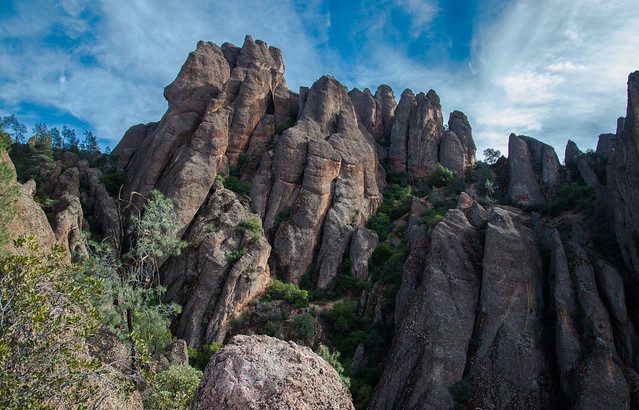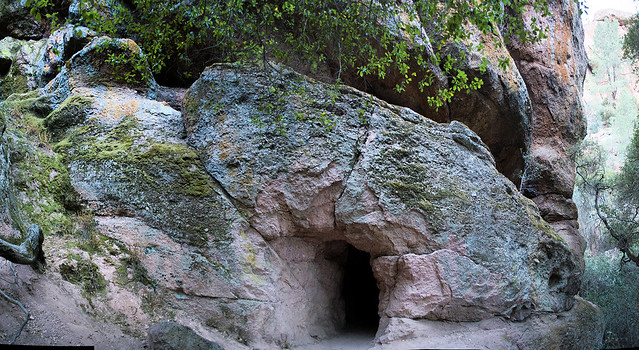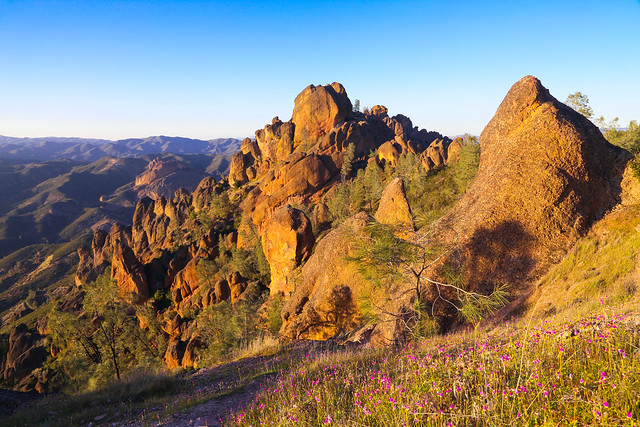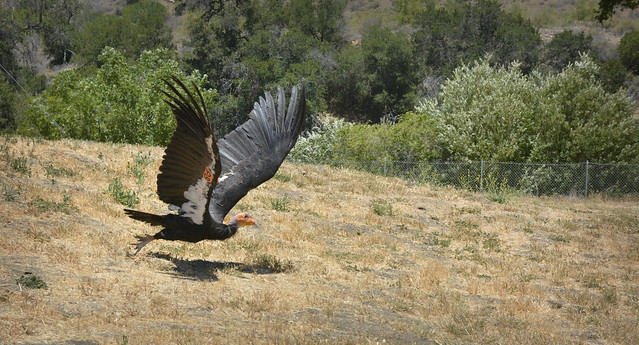Charred spires and fins stand in rows along hilltops, their crevices filled with giant boulders and tall spouts of green vegetation. Hundreds of feet above, and against the backdrop of a blue sky, the largest North American land bird, the California Condor, soars from the edge of an aerie on a faraway cliff. Its signature flat black wings and motionless body distinguish it from other large birds that inhabit the area, such as the turkey vulture.
Tip: Use WalletFlo for all your credit card needs. It’s free and will help you optimize your rewards and savings!
These sights, along with sparkling reservoirs and climbing hiking trails, are what visitors can expect to experience at Pinnacles National Park, the newest addition to the national park family.
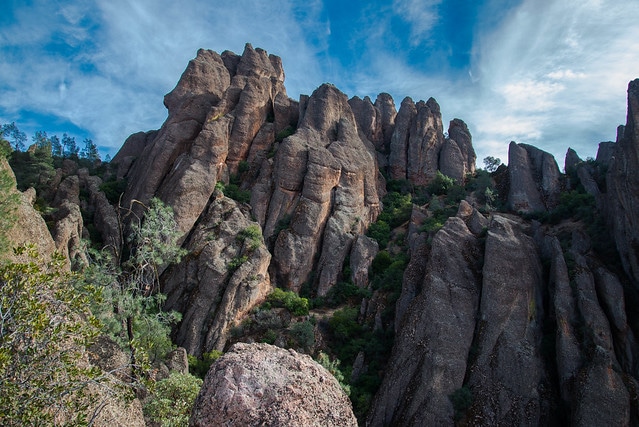
Pinnacles is located in central California, about two hours south of San Francisco and not too far from other notable national parks. Due to shifting plate tectonics, Pinnacles used to be located even farther away. Much farther away in fact.
Scientists estimate that the Pinnacles volcano came into existence approximately twenty-three million years ago. This fifteen-mile-long, five-mile-wide volcano alternated among eruption states of violent explosions, viscous oozes, and periods of dormancy.
What’s astonishing about this volcano isn’t its eruptions but the fact that, millions of years ago when this volcano was active, it was actually located in Southern California near the city of Los Angeles.
Around that same time the Pacific plate was grinding along the North American plate, causing extreme pressure to build up along the fault lines. Eventually this intense pressure forced a part of the North American plate to snap and attach to the Pacific plate, creating what we know today as the San Andreas Fault.
Moreover, it just so happens that the San Andreas Fault ran directly underneath the Pinnacles volcano. As the Pacific plate moved toward the northwest, it took two-thirds of the Pinnacles volcano with it until, after millions of years, it ended up where it is today—195 miles north of its birthplace. Now the Pacific plate continues to slip northward approximately one inch per year.
As the plates took the Pinnacle volcano on this wild ride, the volcano sank until it was completely underground and flanked by other smaller plates that also run under the park. Which raises the question, of course, as to where the actual Pinnacles volcano stands today.
The answer is that there are remnants of this once-violent volcano throughout Pinnacles National Park. However, as we’ve seen so many times at destinations throughout this region, the powerful forces of erosion forced a reawakening of the bedrock and created a magnificent natural landscape.
As thousands of feet of overlaying earth was worn away by water, ice, and wind, the ancient remnants of the volcano were exposed and towering spires “rose from the dead” with massive boulders toppling previous formations to create new caves. The end product was the present-day landscape full of canyons, ridges, crags, channels, and endless igneous pinnacles. These dramatic features sit alongside (and on top of) older granite accumulations as old as one hundred million years, producing a diverse range of old and new geologic wonders.
There are two separate entrances on the east and west sides of the park that don’t connect to each other, so you’ll have to decide which side to spend your time on and then plan your itinerary accordingly. Entrance fees are $30 per vehicle, but if you think you might be bouncing between national parks then you might want to look into getting a national park annual pass to save money on park entry.
Because the park is new and somewhat undiscovered to the masses, you won’t find a lot of amenities in the park, but, if you catch it at the right time, you also won’t have to deal with the herds of visitors that flock to the other nearby parks.
There are ample opportunities for hiking and rock climbing at this park—thirty miles of trails in fact. If you’re a hiker, there are trails suitable for all difficulty levels. The Bear Gulch Caves are perhaps the most popular attraction at Pinnacles, especially for the novice hiker.
The hike to Bear Gulch Reservoir, where you definitely want to start from the east side of the park to make it easier, doesn’t require you to be very physically fit, and the trail is only 2.2 miles round-trip. The hike to the reservoir splits at one point, offering hikers the choice to hike through the popular Bear Gulch Cave or to take an alternate route on the Moses Spring Trail, which goes along the rim of the gorge.
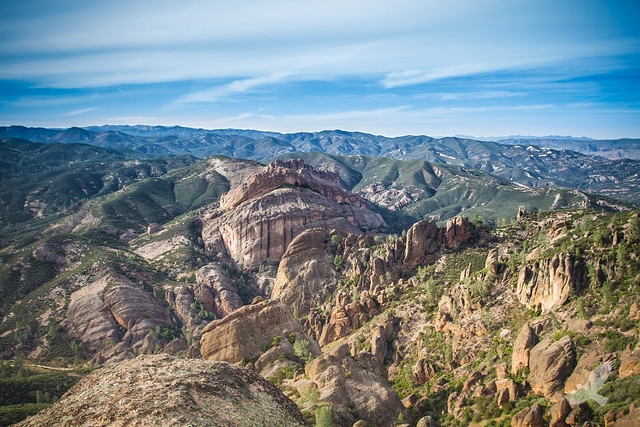
I recommend venturing through the dim (and often dark) Bear Gulch Cave, but just make sure to bring a flashlight or headlamp if you are planning on taking that route. Also check with the park to see if the cave is open, because they close it at times to protect the native bats.
Whichever route you take, you will end up at the scenic Bear Gulch Reservoir at the end of your hike. If you’ve still got a lot of juice left in you, then you might consider hopping on the Rim Trail from the reservoir and connecting to the High Peaks Trail for an extended and more scenic return to your entry point.
A number of other hikes in the park offer spectacular views as well. One hike, the Condor Gulch to High Peaks Loop (5.3 miles round-trip) is a strenuous hike that will take three to five hours, but it’s quite rewarding and takes you right through the heart of the Pinnacles volcano.
That would be my recommendation if you’re confident in your fitness level. If you’re looking for something a little less strenuous but still want to see some stunning scenery, then consider the Condor Gulch Trail which is only 1.7 miles one way. Condor gives you great views of the high peaks at only one mile into the hike and also the option of continuing on with a more strenuous path if you feel inclined to do so.
Finally one of the other primary attractions of the park is the wildlife viewing. Because Pinnacles National Park lies at the interface of northern, southern, coastal, and inland California, a good variety of plants and animals inhabit the park and coexist unlike anything you’re likely to see otherwise.
The NPS reports that there are 149 species of birds, 49 mammals, 22 reptiles, 69 butterflies, and nearly 400 bees, to name only a few. Of all the animals found here at Pinnacles, perhaps the most coveted is the California condor, the largest land bird in North America with a wingspan of up to 9.5 feet.
Tip: Use WalletFlo for all your credit card needs. It’s free and will help you optimize your rewards and savings!
Unlike their fellow scavenger, the turkey vulture, California condors have a poor sense of smell and instead rely on their remarkable eyesight to find the carrion (dead animal carcasses) they consume. Their bald heads, while unsightly, are specially adapted so that they are easier to clean after diving into rotten animal corpses. This exposed skin on the condor’s head is also capable of changing color, depending on the emotional state of the bird—a valuable adaptation that helps condors communicate with each other.
California condors once inhabited the entire United States, but, after a combination of changing temperatures and human activities like poaching, their numbers dropped to a mere twenty-two birds worldwide in the twentieth century.
As a result, the California Condor Recovery Program was initiated in 1987, and every wild condor known to exist was brought into captivity for breeding programs.
It was a bold, controversial move and involved unusual techniques like using puppets to feed baby condors so that the adults would lay more eggs. However, the program has successfully repopulated these birds to about 435 worldwide, reintroducing these birds to the wild in different areas of Arizona, California, and Baja California, Mexico.

Pinnacles has been part of the California Condor Recovery Program, and since 2003 there are now twenty-seven condors that roam free in the park. You’ll come across mixed reviews by visitors of actual condor sightings, as it seems that some see handfuls of condors throughout their visit, while others see none at all.
This is due in part to the small number of condors that actually inhabit the park, as well as the fact that these magnificent creatures are known to move frequently throughout their territory which extends as far west as Big Sur.
But if you really want to catch a glimpse of a California condor, then your best shot is to go to High Peaks (strenuous hike required) area in the early morning or evening. Another place to check is Bench Trail (near the visitor center) in the morning, where the park offers spotting scopes to aid with your viewing.
Tips
- Though the park is new, it’s rapidly growing in popularity. If you’re visiting on the weekend, make sure you arrive as early as possible to secure parking. Otherwise you will have to hike about eight miles total from the visitor center. A shuttle bus does run on Sundays, but I recommend just arriving early before the rush of weekend visitors.
- Keep in mind that, during the summer, this park can get really hot, and there is limited shade on many of the trails, so be sure to bring plenty of water. Spring and fall are likely the best times to visit for ideal weather.
- Don’t get confused if you come across signs or markers on maps for Pinnacles National Monument. Remember, this is a new national park and used to be known as a national monument.
Daniel Gillaspia is the Founder of UponArriving.com and the credit card app, WalletFlo. He is a former attorney turned travel expert covering destinations along with TSA, airline, and hotel policies. Since 2014, his content has been featured in publications such as National Geographic, Smithsonian Magazine, and CNBC. Read my bio.

